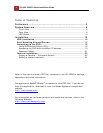
ESV16U, ESV32U Quick Installation Guide 5
14. Overloading
Do not overload the power supply or extension cords as this can result in a
risk of fire or electric shock.
15. Object and Liquid Entry
Never push objects of any kind into this NVR through openings as they may
touch dangerous electrical points or short-out parts that could result in a fire
or electrical shock. Never intentionally spill liquid of any kind on the NVR.
16. Servicing
Do not attempt to service this NVR yourself as opening or removing covers
may expose you to dangerous electrical or other hazards. Refer all servicing
to qualified service personnel.
17. Damage Requiring Service
Disconnect this NVR from the power supply and refer servicing to qualified
service personnel under the following conditions.
a. When the power-supply cord or plug is damaged.
b. If liquid has been spilled, or objects have fallen into the NVR.
c. If the NVR has been submerged in water.
d. If the NVR does not operate normally by following the operating
instructions in the user's manual. Adjust only those controls that are
covered by the user's manual as an improper adjustment of other controls
may result in damage and will often require extensive work by a qualified
technician to restore the NVR to its normal operation.
e. If the NVR has been dropped or the cabinet has been damaged.
f. When the NVR exhibiting a distinct change in performance which indicates
a need for service.
g. Other trouble.
18. Other trouble. Replacement Parts
When replacing parts, be sure the service technician uses parts specified by
the manufacturer or have the same characteristics as the original part.
Unauthorized substitutions may result in fire, electric shock or other hazards.
19. Safety Check
Upon completion of any service or repairs to this NVR, ask the service
technician to perform safety checks to determine that the NVR is in proper
operating condition.


















